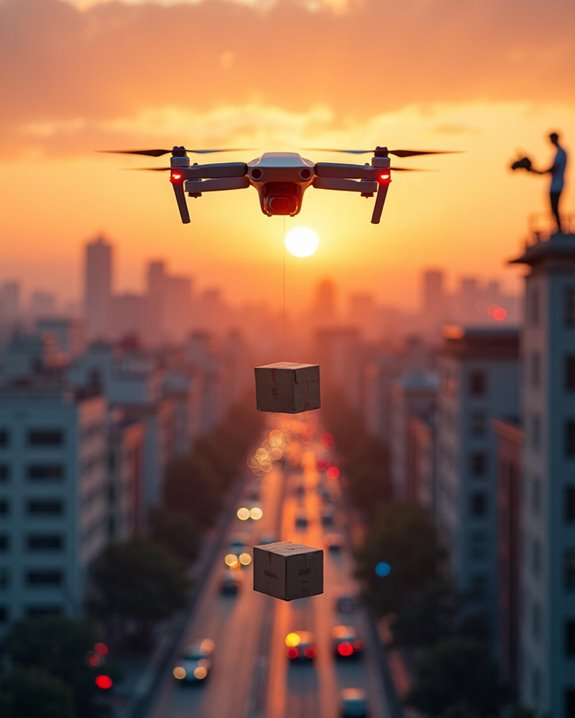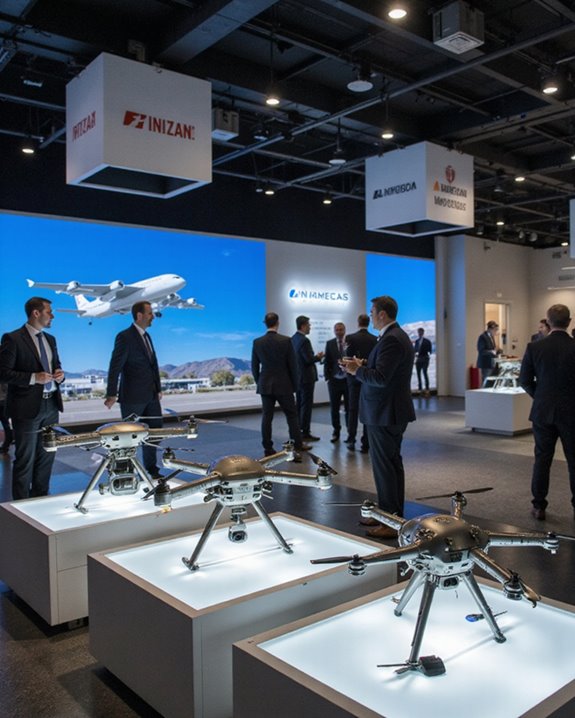Profitable drone business opportunities encompass aerial photography and videography for real estate and events, infrastructure inspection services projected to reach $1.1 billion by 2025, and logistics operations forecasted to exceed $10.5 billion globally. Agricultural drone services, targeting precision farming applications, are expected to hit $893 million, while security and surveillance sectors continue expanding through AI integration. Success requires FAA Part 107 certification, professional equipment ranging from $1,000-$2,000, and strategic market positioning. Further exploration reveals thorough strategies for maximizing revenue potential in this rapidly evolving industry.
Key Takeaways
- Real estate aerial photography services offer immediate revenue potential, with project rates ranging from $75 to $500 per shoot.
- Construction inspection and surveying services tap into a growing billion-dollar market while requiring specialized drone equipment.
- Agricultural drone services provide precision farming solutions, meeting increasing demand in the expanding USD 893 million market.
- Security and surveillance operations generate steady income through AI-integrated monitoring and regular client subscriptions.
- Delivery drone services present significant opportunities in logistics, with the market projected to exceed USD 10.5 billion globally.
The Most Profitable Drone Services in Today’s Market
The drone services market has experienced substantial growth across multiple high-value sectors, with several service categories emerging as particularly lucrative opportunities for entrepreneurs and businesses. Aerial photography and videography services command premium pricing in commercial applications, particularly in real estate, media, and event sectors, while inspection and surveying services are projected to reach USD 1.1 billion in the construction sector alone by 2025. Global expansion in logistics drone services indicates significant potential, with market valuations expected to exceed USD 10.5 billion by 2025. These technological trends are further amplified in agricultural applications, where the drone market is forecasted to reach USD 893 million, driven by precision farming demands and sustainable agriculture practices. Security and surveillance services continue to expand through AI integration and rising worldwide security requirements.
Essential Equipment and Skills for Starting a Drone Business
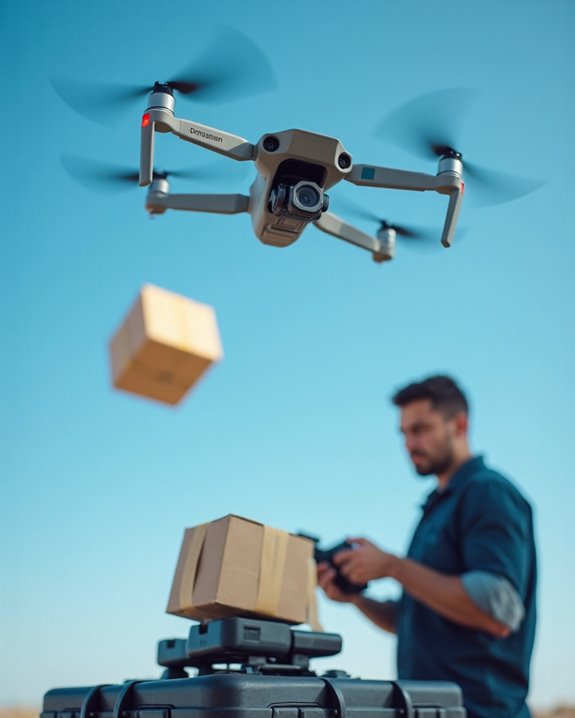
Launching a successful drone business requires a thorough suite of equipment and skills that extend far beyond basic flight capabilities. Essential hardware investments include commercial drones ($1,000-$2,000), controllers, and equipment for battery efficiency optimization, while software solutions encompass flight planning tools and data analysis platforms. Professional operators must obtain FAA Part 107 certification and undergo thorough skill enhancement training in safety protocols, emergency procedures, and industry-specific applications.
Beyond technical requirements, successful drone businesses need robust marketing infrastructure, including professional websites, branding materials, and strategic social media presence. Protective equipment, including impact-resistant cases, safety gear, and weather monitoring tools, guarantees operational continuity and risk mitigation. The combination of technical proficiency, safety protocols, and business acumen creates a foundation for sustainable commercial drone operations.
Legal Requirements and Certifications for Drone Operators
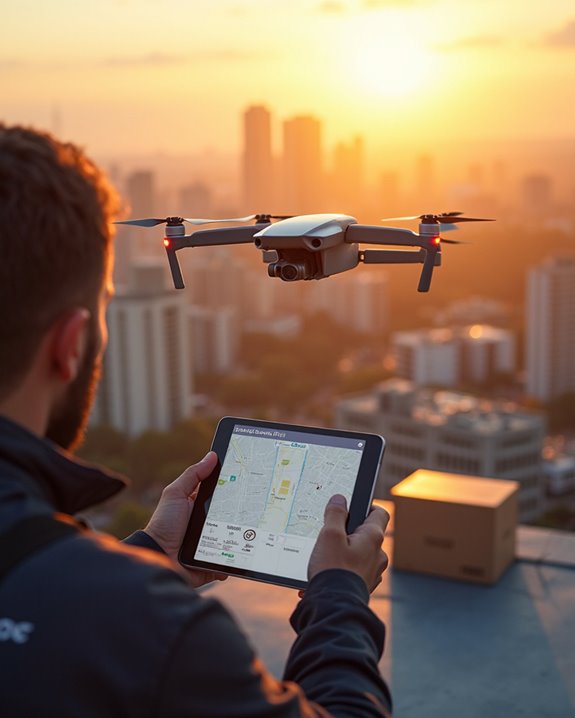
Becoming a legal commercial drone operator requires obtaining specific certifications and meeting strict regulatory requirements established by the Federal Aviation Administration (FAA). According to eligibility rules, applicants must be at least 16 years old, demonstrate English proficiency, and maintain appropriate physical and mental fitness to operate unmanned aircraft systems.
Operators must pass a thorough knowledge exam covering Part 107 regulations, airspace classifications, weather patterns, and operational procedures. The certification process involves creating an IACRA account to obtain an FAA Tracking Number, completing the aeronautical knowledge test at an approved testing center, and submitting the required documentation. Certificate holders must also complete recurrent training every 24 months to maintain their certification, ensuring continued compliance with FAA regulations and staying current with industry standards.
Revenue Streams and Pricing Models in Drone Services
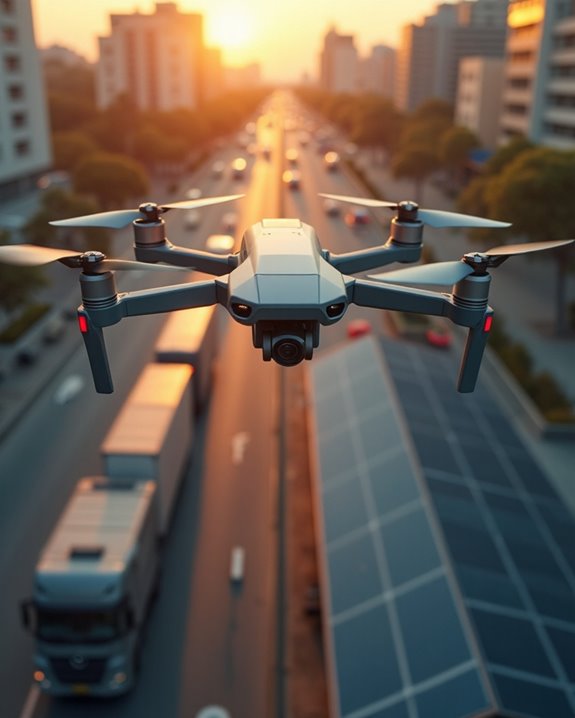
Once commercial drone operators have secured their necessary FAA certifications, establishing effective revenue streams and pricing structures becomes paramount for business sustainability. Operators can generate income through multiple channels, including aerial photography, surveying, inspections, and delivery services, with pricing models tailored to specific market segments and project requirements.
Dynamic pricing strategies incorporate factors such as pilot expertise, equipment specifications, and geographic location, typically ranging from $75 to $500 per project for photography services and $50 to $200 per hour for specialized operations. Subscription models offer stability through recurring revenue, particularly beneficial for clients requiring regular services. When determining pricing structures, operators must consider operational overhead, market competition, and service quality while ensuring scalability for business growth. Additional revenue opportunities exist in post-production services, data analysis, and specialized applications for disaster response and infrastructure assessment.
Building a Client Base and Marketing Your Drone Business
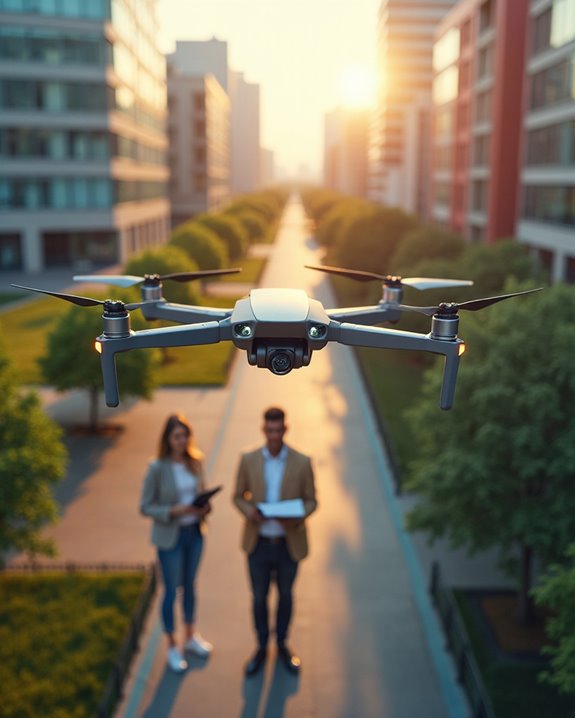
In today’s competitive drone services market, establishing a robust client base requires a strategic combination of digital presence, targeted marketing initiatives, and relationship-building techniques. Successful Brand Strategies encompass creating a distinctive value proposition, maintaining consistent branding across platforms, and developing a professional website that showcases service capabilities and client testimonials.
Content Engagement plays a pivotal role through high-quality aerial visuals, compelling storytelling, and educational materials that demonstrate industry expertise. Businesses can amplify their reach through strategic partnerships, targeted social media campaigns, and guerrilla marketing tactics such as live demonstrations. Implementation of data analytics enables performance tracking, while client feedback mechanisms and loyalty programs foster long-term relationships. Integration of emerging technologies, including AI-enhanced operations and sustainable practices, further strengthens market positioning and client acquisition efforts.
Frequently Asked Questions
How Long Does It Take to Become a Proficient Commercial Drone Pilot?
Becoming a proficient commercial drone pilot typically requires 15-20 training hours for FAA Part 107 certification, followed by 3-6 months of practical experience to develop advanced flight skills. The skill timeline varies based on frequency of practice, complexity of operations, and specific industry requirements. Pilots generally achieve basic proficiency within the first month of regular flying, while mastering specialized applications, such as precision mapping or cinematography, may require additional months of dedicated practice.
What Insurance Coverage Do I Need for Different Types of Drone Operations?
After a commercial drone operator in California faced a $50,000 lawsuit for accidentally damaging property during a real estate shoot, the importance of extensive drone insurance became evident. Coverage options vary by operation type: aerial photography typically requires $1-2 million in liability coverage, delivery services need additional cargo insurance, while construction monitoring demands both hull and liability protection. Basic requirements include liability insurance, though payload-specific coverage may be necessary for specialized equipment.
Can I Operate Drones Internationally With My Current Certification?
Domestic drone certifications typically do not automatically transfer internationally. Operators must obtain country-specific authorizations, considering both License Recognition agreements and Visa Requirements for commercial operations. The EU requires EASA certification for operations within member states, while the FAA mandates foreign operators to acquire US certification. Pilots must research destination countries’ specific regulatory frameworks, register their drones locally, and secure additional permits or validations before conducting any drone operations abroad.
How Often Should I Upgrade My Drone Equipment to Stay Competitive?
In the rapidly evolving drone industry, where technology advances at lightning speed, operators must carefully balance upgrade frequency with operational needs. Equipment trends suggest upgrading essential components every 12-18 months, focusing on battery systems, cameras, and control modules. However, high-use commercial operators should consider more frequent updates, particularly when new technology offers significant competitive advantages in efficiency, range, or payload capacity. Market demands and regulatory changes also influence ideal upgrade timing.
What Weather Conditions Are Considered Safe for Commercial Drone Operations?
Safe commercial drone operations require specific weather parameters: visibility of at least three miles from the control station, temperatures between 32°F and 104°F to maintain ideal battery life, and wind speeds below 15 mph. Operators should avoid precipitation, as moisture can compromise drone maintenance and electronic components. Clear or partly cloudy conditions are ideal, while maintaining proper distance from clouds (500 feet below and 2,000 feet horizontally) as per FAA regulations.

